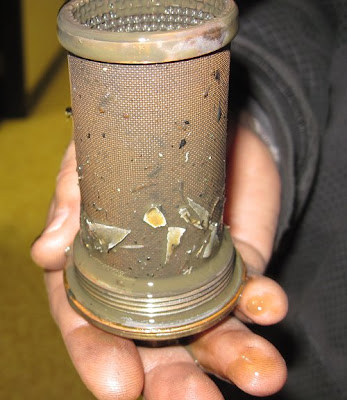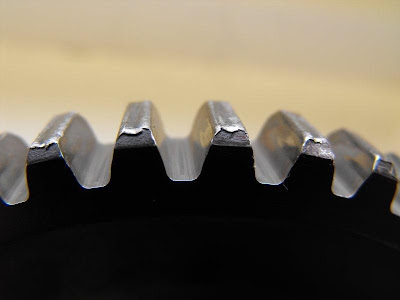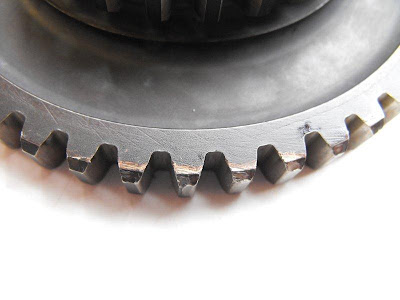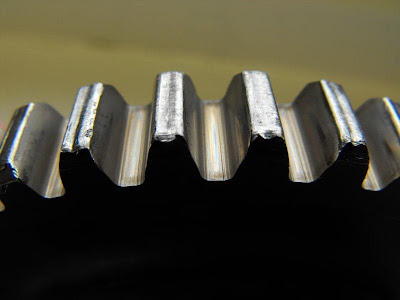Pilawt
Final Approach
- Joined
- Sep 19, 2005
- Messages
- 9,479
- Display Name
Display name:
Pilawt
The Sport Cub was in for its annual. I was at work and got the dreaded phone call from the shop: "You might want to come down here and take a look at this ... "

This is the oil screen of my Sport Cub's Continental O-200-A with 290 hours total time since new. All previous oil analyses had been normal, the latest 25 tach hours ago.
In addition to the obvious large aluminum flakes, the oil filter had steel shards 3/16" or so long.
Odd thing found on the crankshaft gear, P/N 656762. The starter has ridden up on the top of the teeth and “milled” off the top. About 25 teeth have some damage with some worse than others. The steel shards appeared to be coming from this gear.



The shop took off the #1 rod and found metal in the bearing. They took the engine apart. Metal has circulated throughout the engine. Crankshaft gear appears to be the source of the steel. They think the aluminum flakes were stuck in the accessory housing from manufacture and came loose from their hiding spot. No way these pieces came up the pickup tube or went through the oil pump. They are too big and too intact.
According to the shop, it looks like the lack of a lead-in on the teeth of the crankshaft gear is forcing the bendix to “ride up” on top of the tooth instead of properly engaging. I'm told Continental recently redesigned the gear to eliminate the "lead-in" bevel.
I chose the Sport Cub because it had a legacy, "proven" engine. I've been flying Cessna 150s with the O-200-A since the mid-1960s, and have owned two of them; so I figured I had developed a good working relationship with this type of engine.
Guess not.
This is the same engine that needed a top overhaul at 125 hours because of defective valve seats that caused exhaust leaks in all four cylinders, with compression down to 40 in one of them. Continental covered the repair on that one. This time they're offering the parts at 50%, no allowance for labor.
Getting past the cost, my concern is that if the engine is repaired, will the same thing happen again in another 300 hours? Continental says the old-style beveled ring gear is no longer available. Mine is one of about 95 O-200-A-powered Sport Cubs in the fleet, and no one has heard of a similar occurrence in any of the others.
Any thoughts, suggestions, advice, shoulders to cry on, etc., would be appreciated.


This is the oil screen of my Sport Cub's Continental O-200-A with 290 hours total time since new. All previous oil analyses had been normal, the latest 25 tach hours ago.
In addition to the obvious large aluminum flakes, the oil filter had steel shards 3/16" or so long.
Odd thing found on the crankshaft gear, P/N 656762. The starter has ridden up on the top of the teeth and “milled” off the top. About 25 teeth have some damage with some worse than others. The steel shards appeared to be coming from this gear.



The shop took off the #1 rod and found metal in the bearing. They took the engine apart. Metal has circulated throughout the engine. Crankshaft gear appears to be the source of the steel. They think the aluminum flakes were stuck in the accessory housing from manufacture and came loose from their hiding spot. No way these pieces came up the pickup tube or went through the oil pump. They are too big and too intact.
According to the shop, it looks like the lack of a lead-in on the teeth of the crankshaft gear is forcing the bendix to “ride up” on top of the tooth instead of properly engaging. I'm told Continental recently redesigned the gear to eliminate the "lead-in" bevel.
I chose the Sport Cub because it had a legacy, "proven" engine. I've been flying Cessna 150s with the O-200-A since the mid-1960s, and have owned two of them; so I figured I had developed a good working relationship with this type of engine.
Guess not.
This is the same engine that needed a top overhaul at 125 hours because of defective valve seats that caused exhaust leaks in all four cylinders, with compression down to 40 in one of them. Continental covered the repair on that one. This time they're offering the parts at 50%, no allowance for labor.
Getting past the cost, my concern is that if the engine is repaired, will the same thing happen again in another 300 hours? Continental says the old-style beveled ring gear is no longer available. Mine is one of about 95 O-200-A-powered Sport Cubs in the fleet, and no one has heard of a similar occurrence in any of the others.
Any thoughts, suggestions, advice, shoulders to cry on, etc., would be appreciated.

